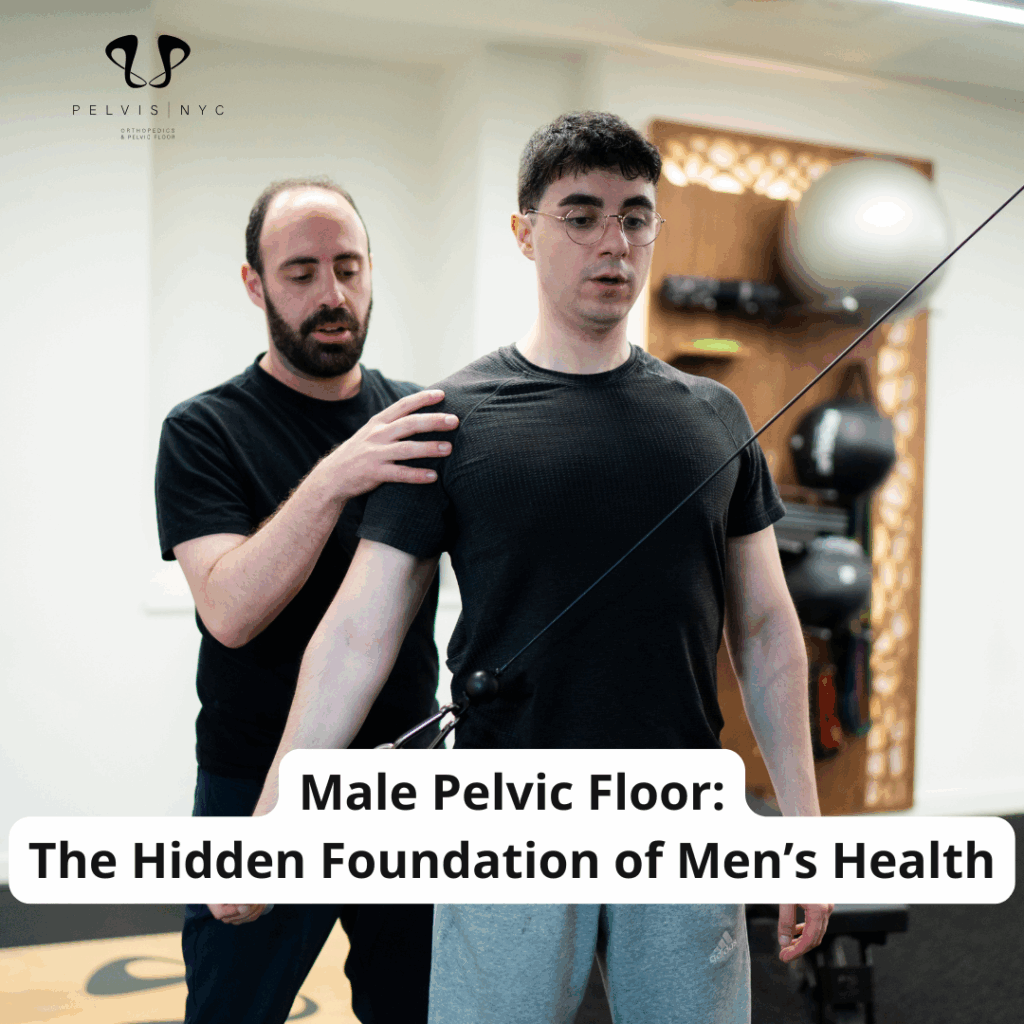Welcome, gentlemen to a topic that’s often overlooked but critically important—pelvic floor health in men. This part of your body might not grab headlines, but it plays a pivotal role in your overall well-being. Pelvic floor issues are a significant health concern that can impact men, often linked to prostate surgery and presenting symptoms like urinary incontinence and pelvic pain. Many may view these symptoms as normal for their age instead of seeking help. Today, we’ll explore why maintaining a healthy pelvic floor is essential, uncover common issues men face, and provide practical tips to keep your pelvic floor in top condition.
What Are Pelvic Floor Muscles?
Pelvic floor muscles are a group of muscles that stretch from the pubic bone at the front to the tailbone at the back, forming a sling or hammock across the pelvis. These muscles play a vital role in supporting the bladder, and bowel. They are crucial for maintaining control over bladder and bowel movements, and they also contribute to sexual function. Strengthening these muscles through specific exercises, such as Kegels, can prevent or alleviate various issues, including incontinence and pelvic pain.
Understanding the Male Pelvic Floor
The pelvic floor is a complex and vital group of muscles, ligaments, and connective tissues located at the base of your pelvis. This structure supports key pelvic organs such as the bladder, bowel, and prostate. The pelvic floor muscles extend from the pubic bone to the coccyx, providing essential support and stability. Imagine it as the foundation of a building—strong and stable, it ensures everything above functions smoothly.
Common Pelvic Floor Dysfunction Issues in Men
Men often don’t realize they’re dealing with pelvic floor problems until symptoms become disruptive. Some common issues include:
- Urinary Incontinence: This can range from occasional leaks to more significant control issues.
- Erectile Dysfunction: Weak pelvic floor muscles can contribute to difficulties in maintaining an erection.
- Pelvic Pain: Chronic discomfort in the pelvic region can be a sign of underlying muscle tension or dysfunction.
- Prostate-Related Issues: Post-surgery or other prostate conditions can weaken the pelvic floor.
Pelvic floor problems can arise from various causes, including aging, obesity, lifestyle habits, and even ongoing health conditions like chronic cough or heavy lifting. But here’s the good news—many of these issues can be managed or even prevented with proper care, including pelvic floor therapy and rehabilitation.
The Benefits of a Strong Pelvic Floor
Why should you care about your pelvic floor? The benefits are far-reaching:
- Improved Urinary Control: Strengthening your pelvic floor helps reduce incontinence and improve bladder control, addressing issues related to pelvic floor weakness.
- Enhanced Sexual Performance: A strong pelvic floor can lead to better erections and increased sexual satisfaction for both you and your partner.
- Better Core Stability: The pelvic floor is a key player in core stability, which impacts your posture and balance.
- Pain Relief: Targeted exercises can alleviate chronic pelvic pain, often associated with conditions like chronic pelvic pain syndrome (CPPS).
Tips for Maintaining Optimal Pelvic Floor Health with Pelvic Floor Exercises
Maintaining your pelvic floor health doesn’t have to be complicated. Here’s how you can start:
- Pelvic Floor Exercises: Kegel exercises are your best friend here. They’re simple, discreet, and effective. Focus on contracting and relaxing your pelvic muscles regularly to build strength and endurance.
- Healthy Bowel Habits: Stay regular by eating a fiber-rich diet and staying hydrated. Avoid straining during bowel movements, as this puts unnecessary pressure on your pelvic floor and can affect both bladder and bowel control.
- Posture and Body Mechanics: Pay attention to how you sit and lift. Proper posture and correct body mechanics reduce the strain on your pelvic floor and support overall stability.
- Weight Management: Keeping a healthy weight minimizes the pressure on your pelvic floor, reducing the risk of related issues.
- Consult a Physical Therapist: If you’re experiencing persistent symptoms, don’t hesitate to seek professional guidance. A physical therapist specializing in pelvic health can offer personalized advice and effective treatment strategies, including pelvic floor physical therapy.
A Physical Therapist’s Perspective
From a physical therapist’s point of view, the male pelvic floor is often neglected in discussions about men’s health, yet it’s a cornerstone of physical wellness. We see numerous cases where early intervention and proper exercise regimens, often guided by a pelvic floor physical therapist, can prevent or alleviate symptoms that might otherwise require surgical intervention. Taking charge of your pelvic health now can lead to a higher quality of life as you age.
Remember, gentlemen, investing in your pelvic floor health is an investment in your future vitality and happiness. Don’t wait until problems arise—start strengthening your foundation today by consulting a pelvic health physiotherapist who can provide specialized care for issues related to pelvic floor muscle problems.
For more information or to book a consultation, visit PELVIS NYC and take advantage of our FREE 15-minute teleconsultation offer.




No comment yet, add your voice below!